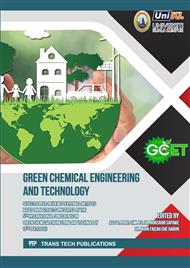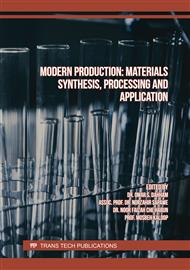[1]
B. Bin Huang, H. C. Lin, and Y. W. Chang, Analysis of proteins and potential bioactive peptides from tilapia (Oreochromis spp.) processing co-products using proteomic techniques coupled with BIOPEP database,, J. Funct. Foods, vol. 19, p.629–640, (2015).
DOI: 10.1016/j.jff.2015.09.065
Google Scholar
[2]
P. Pędziwiatr, D. Zawadzki, and K. Michalska, Aquaculture waste management,, Acta Innov., vol. 22, no. 22, p.20–29, (2017).
Google Scholar
[3]
J. Roslan, K. F. M. Yunos, N. Abdullah, and S. M. M. Kamal, Characterisation of Fish Protein Hydrolysate from Tilapia (Oreochromis Niloticus) by-Product,, Agric. Agric. Sci. Procedia, vol. 2, no. December, p.312–319, (2014).
DOI: 10.1016/j.aaspro.2014.11.044
Google Scholar
[4]
X. Hua et al., Successive digestion of tilapia collagen by serine proteinase and proline specific endopeptidase to produce novel angiotensin I-converting enzyme inhibitory peptides,, Mar. Life Sci. Technol., vol. 2, no. 3, p.268–278, (2020).
DOI: 10.1007/s42995-020-00038-y
Google Scholar
[5]
H. C. Lin, A. M. Alashi, R. E. Aluko, B. S. Pan, and Y. W. Chang, Antihypertensive properties of tilapia (Oreochromis spp.) frame and skin enzymatic protein hydrolysates,, Food Nutr. Res., vol. 61, no. 1, (2017).
DOI: 10.1080/16546628.2017.1391666
Google Scholar
[6]
K. Yamamoto et al., Biological safety of fish (tilapia) collagen,, Biomed Res. Int., vol. 2014, p.1–9, (2014).
Google Scholar
[7]
L. Sun, H. Hou, B. Li, and Y. Zhang, Characterisation of acid- and pepsin-soluble collagen extracted from the skin of Nile tilapia (Oreochromis niloticus),, Int. J. Biol. Macromol., vol. 99, p.8–14, (2017).
DOI: 10.1016/j.ijbiomac.2017.02.057
Google Scholar
[8]
S. Choonpicharn, S. Jaturasitha, N. Rakariyatham, N. Suree, and H. Niamsup, Antioxidant and antihypertensive activity of gelatin hydrolysate from Nile tilapia skin,, J. Food Sci. Technol., vol. 52, no. 5, p.3134–3139, (2015).
DOI: 10.1007/s13197-014-1581-6
Google Scholar
[9]
N. A. Daud, A. S. Babji, and S. M. Yusop, Effects of Enzymatic Hydrolysis on the Antioxidative and Antihypertensive Activities from Red Tilapia Fish Protein,, J. Nutr. Food Sci., vol. 05, no. 387, (2015).
DOI: 10.4172/2155-9600.1000387
Google Scholar
[10]
K. F. Pa'ee, N. Razali, S. R. Sarbini, S. N. Ramonaran Nair, K. Yong Tau Len, and N. Abd-Talib, The production of collagen type I hydrolyzate derived from tilapia (Oreochromis sp.) skin using thermoase PC10F and its in silico analysis,, Food Biotechnol., vol. 35, no. 1, p.1–21, (2021).
DOI: 10.1080/08905436.2020.1869040
Google Scholar
[11]
M. Tu, S. Cheng, W. Lu, and M. Du, Advancement and prospects of bioinformatics analysis for studying bioactive peptides from food-derived protein: Sequence, structure, and functions, vol. 105. Elsevier B.V., (2018).
DOI: 10.1016/j.trac.2018.04.005
Google Scholar
[12]
E. C. Y. Li-Chan, Bioactive peptides and protein hydrolysates: Research trends and challenges for application as nutraceuticals and functional food ingredients,, Curr. Opin. Food Sci., vol. 1, no. 1, p.28–37, (2015).
DOI: 10.1016/j.cofs.2014.09.005
Google Scholar
[13]
P. Minkiewicz, J. Dziuba, A. Iwaniak, M. Dziuba, and M. Darewicz, BIOPEP database and other programs for processing bioactive peptide sequences,, J. AOAC Int., vol. 91, no. 4, p.965–980, (2008).
DOI: 10.1093/jaoac/91.4.965
Google Scholar
[14]
G. Li, G. Le, Y. Shi, and S. Shrestha, Angiotensin I – converting enzyme inhibitory peptides derived from food proteins and their physiological and pharmacological effects,, vol. 24, p.469–486, (2004).
DOI: 10.1016/s0271-5317(04)00058-2
Google Scholar
[15]
J. Y. Ko et al., Angiotensin I-converting enzyme inhibitory peptides from an enzymatic hydrolysate of flounder fish (Paralichthys olivaceus) muscle as a potent antihypertensive agent,, Process Biochem., vol. 51, no. 4, p.535–541, (2016).
DOI: 10.1016/j.procbio.2016.01.009
Google Scholar
[16]
F. De Leo, S. Panarese, R. Gallerani, and L. Ceci, Angiotensin Converting Enzyme (ACE) Inhibitory Peptides: Production and Implementation of Functional Food,, Curr. Pharm. Des., vol. 15, no. 31, p.3622–3643, (2009).
DOI: 10.2174/138161209789271834
Google Scholar
[17]
S. Manoharan, A. S. Shuib, N. Abdullah, and K. Lumpur, Structural Characteristics And Antihypertensive Effects Of Angiotensin-I- Converting Enzyme Inhibitory Peptides In The Renin-Angiotensin And Kallikrein Kinin Systems,, vol. 14, p.383–406, (2017).
DOI: 10.21010/ajtcam.v14i2.39
Google Scholar
[18]
P. Suganya, S. kalva, and L. Saleena, Molecular Docking and Dynamics Simulation Study on the Influence of Zn2+ on the Binding Modes of Aggrecanase with its Inhibitors,, Comb. Chem. High Throughput Screen., vol. 17, no. 10, p.891–903, (2014).
DOI: 10.2174/1386207317666141113155141
Google Scholar
[19]
V. Vermeirssen, J. Van Camp, and W. Verstraete, Bioavailability of angiotensin I converting enzyme inhibitory peptides,, Br. J. Nutr., vol. 92, no. 3, p.357–366, (2004).
DOI: 10.1079/bjn20041189
Google Scholar
[20]
A. Thomas, R. Meurisse, B. Charloteaux, and R. Brasseur, Aromatic side-chain interactions in proteins. I. Main structural features,, Proteins Struct. Funct. Genet., vol. 48, no. 4, p.628–634, (2002).
DOI: 10.1002/prot.10190
Google Scholar
[21]
J. Caballero, Considerations for docking of selective angiotensin-converting enzyme inhibitors,, Molecules, vol. 25, no. 2, p.1–19, (2020).
DOI: 10.3390/molecules25020295
Google Scholar



